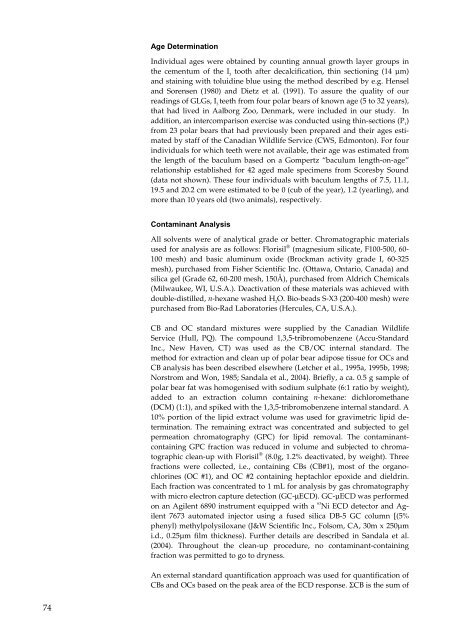Organohalogen concentrations and a gross and histologic ...
Organohalogen concentrations and a gross and histologic ...
Organohalogen concentrations and a gross and histologic ...
Create successful ePaper yourself
Turn your PDF publications into a flip-book with our unique Google optimized e-Paper software.
74<br />
Age Determination<br />
Individual ages were obtained by counting annual growth layer groups in<br />
the cementum of the I 3 tooth after decalcification, thin sectioning (14 µm)<br />
<strong>and</strong> staining with toluidine blue using the method described by e.g. Hensel<br />
<strong>and</strong> Sorensen (1980) <strong>and</strong> Dietz et al. (1991). To assure the quality of our<br />
readings of GLGs, I 3 teeth from four polar bears of known age (5 to 32 years),<br />
that had lived in Aalborg Zoo, Denmark, were included in our study. In<br />
addition, an intercomparison exercise was conducted using thin-sections (P 1 )<br />
from 23 polar bears that had previously been prepared <strong>and</strong> their ages estimated<br />
by staff of the Canadian Wildlife Service (CWS, Edmonton). For four<br />
individuals for which teeth were not available, their age was estimated from<br />
the length of the baculum based on a Gompertz “baculum length-on-age”<br />
relationship established for 42 aged male specimens from Scoresby Sound<br />
(data not shown). These four individuals with baculum lengths of 7.5, 11.1,<br />
19.5 <strong>and</strong> 20.2 cm were estimated to be 0 (cub of the year), 1.2 (yearling), <strong>and</strong><br />
more than 10 years old (two animals), respectively.<br />
Contaminant Analysis<br />
All solvents were of analytical grade or better. Chromatographic materials<br />
used for analysis are as follows: Florisil ® (magnesium silicate, F100-500, 60-<br />
100 mesh) <strong>and</strong> basic aluminum oxide (Brockman activity grade I, 60-325<br />
mesh), purchased from Fisher Scientific Inc. (Ottawa, Ontario, Canada) <strong>and</strong><br />
silica gel (Grade 62, 60-200 mesh, 150Å), purchased from Aldrich Chemicals<br />
(Milwaukee, WI, U.S.A.). Deactivation of these materials was achieved with<br />
double-distilled, n-hexane washed H 2 O. Bio-beads S-X3 (200-400 mesh) were<br />
purchased from Bio-Rad Laboratories (Hercules, CA, U.S.A.).<br />
CB <strong>and</strong> OC st<strong>and</strong>ard mixtures were supplied by the Canadian Wildlife<br />
Service (Hull, PQ). The compound 1,3,5-tribromobenzene (Accu-St<strong>and</strong>ard<br />
Inc., New Haven, CT) was used as the CB/OC internal st<strong>and</strong>ard. The<br />
method for extraction <strong>and</strong> clean up of polar bear adipose tissue for OCs <strong>and</strong><br />
CB analysis has been described elsewhere (Letcher et al., 1995a, 1995b, 1998;<br />
Norstrom <strong>and</strong> Won, 1985; S<strong>and</strong>ala et al., 2004). Briefly, a ca. 0.5 g sample of<br />
polar bear fat was homogenised with sodium sulphate (6:1 ratio by weight),<br />
added to an extraction column containing n-hexane: dichloromethane<br />
(DCM) (1:1), <strong>and</strong> spiked with the 1,3,5-tribromobenzene internal st<strong>and</strong>ard. A<br />
10% portion of the lipid extract volume was used for gravimetric lipid determination.<br />
The remaining extract was concentrated <strong>and</strong> subjected to gel<br />
permeation chromatography (GPC) for lipid removal. The contaminantcontaining<br />
GPC fraction was reduced in volume <strong>and</strong> subjected to chromatographic<br />
clean-up with Florisil ® (8.0g, 1.2% deactivated, by weight). Three<br />
fractions were collected, i.e., containing CBs (CB#1), most of the organochlorines<br />
(OC #1), <strong>and</strong> OC #2 containing heptachlor epoxide <strong>and</strong> dieldrin.<br />
Each fraction was concentrated to 1 mL for analysis by gas chromatography<br />
with micro electron capture detection (GC-µECD). GC-µECD was performed<br />
on an Agilent 6890 instrument equipped with a 63 Ni ECD detector <strong>and</strong> Agilent<br />
7673 automated injector using a fused silica DB-5 GC column [(5%<br />
phenyl) methylpolysiloxane (J&W Scientific Inc., Folsom, CA, 30m x 250µm<br />
i.d., 0.25µm film thickness). Further details are described in S<strong>and</strong>ala et al.<br />
(2004). Throughout the clean-up procedure, no contaminant-containing<br />
fraction was permitted to go to dryness.<br />
An external st<strong>and</strong>ard quantification approach was used for quantification of<br />
CBs <strong>and</strong> OCs based on the peak area of the ECD response. ΣCB is the sum of

















